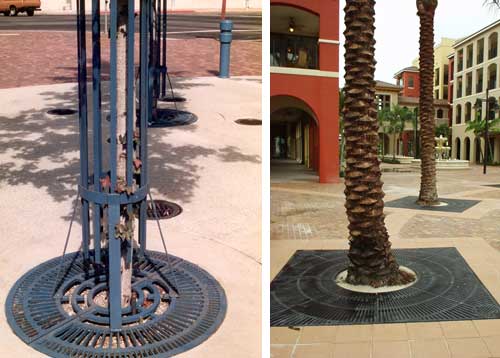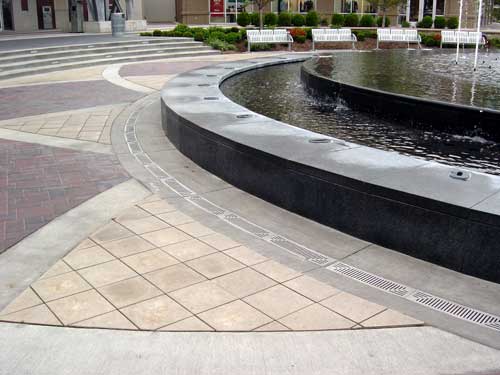Pedestrian Friendly: Planting Trees and Celebrating Stormwater in Urban Areas
Universal Design: Safety, High Heels and Trip Hazards
The Americans for Disability Act (ADA) was initiated in the mid-1990s and its impact had far reaching consequences for designers who care about access both inside and outdoors.   However, some of the first tree grates which were designed with smaller openings were a response to Las Vegas nightclub owners as women were catching their high heels on the tree grate openings.  Older grates have two to three inch "slots" and did not meet the new ADA legislation for trip hazards.  In addition, the larger slots collected more street litter.   The patterns in tree grates have evolved over the years, and many of the traditional patterns were modified to provide a more even walking surface.
The elaborate tree grate designs are based on historic ornamental patterns used for well over a century on downtown streets. |
|
 |
|
Old style tree grate |
New style tree grate |
| Photo courtesy of IRONSMITH | |
Â
The ADA does not specifically address tree grates; however gratings within the "accessible pathway"viii should have openings not greater than ½" wide perpendicular to the general direction of travel. Since the minimum requirement for the accessible pathway is 36" tree grates usually do not intrude into it. However, in a large plaza or with large paving grate systems along a sidewalk, there is a danger of high heels, or canes becoming caught in a larger grate opening. Selecting an ADA compliant tree grate will assure a higher level of pedestrian safety.
The Occupational Safety and Health Administration recommends that walking surfaces have a static coefficient of friction of 0.5. A research project sponsored by the Architectural and Transportation Barriers Compliance Board (Access Board) conducted tests with persons with disabilities and concluded that a higher coefficient of friction was needed by such persons. A static coefficient of friction of 0.6 is recommended for accessible routes and 0.8 for ramps.ix Designers should avoid specifying a high gloss powder coating for walking surfaces as they may be slippery when wet. Â Low gloss textured finishes and unfinished grates will likely meet ADA requirements. In addition, the designer may also specify a slip resistant additive to the enamel or polyurethane paint used on some grates to improve slip resistance.
Low Impact Development − Stormwater Trenches
For many years, stormwater has been managed and hidden through engineering, not celebrated and exposed through art. In the city, beautiful fountains were sculptures using water as a resource, but not a means to integrate the management of water quality with elements of art and play on the street.  A new practice of stormwater management often referred to as LID or Low Impact Development provides a new set of tools for urban designers. New fountains and new stormwater plans include a variety of ways to celebrate water and provide opportunities for humans to interact with waterscapes, a word coined by designer and urban planner, Herbert Dreiseitl. Dreiseitl quotes Leonardo Da Vinci to explain his own fascination with water in urban settings. "Take thought, when you are speaking of water, that you first recount your experiences, and only afterwards, your reflections."x In Dreisetl's plans, communities are invited to think about water as a sustainable resource adding one more natural element to the urban setting.
Low impact development practices are based on the principles that rainfall should be managed at the source through the insertion of smaller water quality control systems.   The goal of LID is to "mimic a site's predevelopment hydrology by using design techniques that infiltrate, filter, store, evaporate, and detain runoff close to its source. Techniques are based on the premise that stormwater management should not be seen as stormwater disposal. Instead of conveying and managing / treating stormwater in large, costly end-of-pipe facilities located at the bottom of drainage areas, LID addresses stormwater through small, cost-effective landscape features located at the lot level. These landscape features, known as Integrated Management Practices (IMPs), are the building blocks of LID. "xiLID principles have been embraced by numerous cities, many of whom have adapted special land development codes to encourage these initiatives.  Some of these practices require the use of new, more visible trenches and drains, and include new sidewalk drain systems, new catchment basins at the end of roof top down spouts, tree box filters and fountain edges.
Trench grates can be specified in standard widths and the manufacturer can assist with installation details.  Trench drains are cast iron, aluminum, or bronze with steel frames. Most cast iron tree grates are so heavy that they act as their own deterrent to unauthorized removal. Aluminum grates are lighter and aluminum has a greater value at recycling centers, so to reduce vandalism, grates can also be ordered with pilfer-proof bolting systems.
Often, in order to create a more natural path for water in the street, designers are challenged to design off the grid, in radial patterns, or along a change in the grade surface. Stormwater trench grates can be designed to meet these challenges as long as the designer understands that these flat planes should be integrated into the slope or the curve in flat, level, segments. The radius must be on "plane" following the change in grade without any leveling changes midslope.  Most concrete installers will assist the designer with the proper slope to the drain along the curved surface.
 |
A radius trench drain serves to drain storm water as well as capture the splash from the fountain in this retail plaza. Photo courtesy of IRONSMITH |
Â









